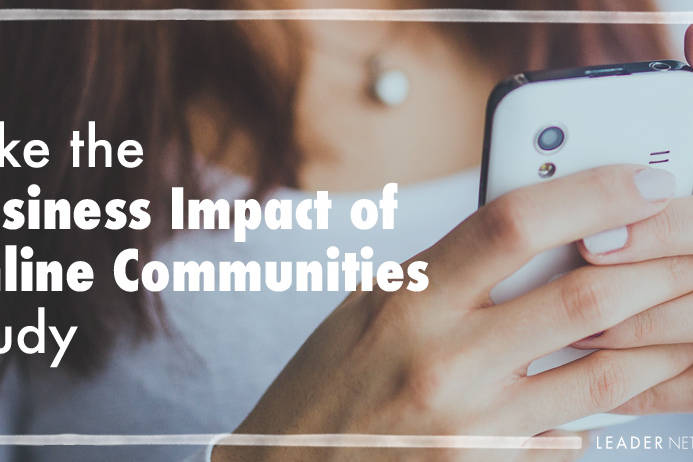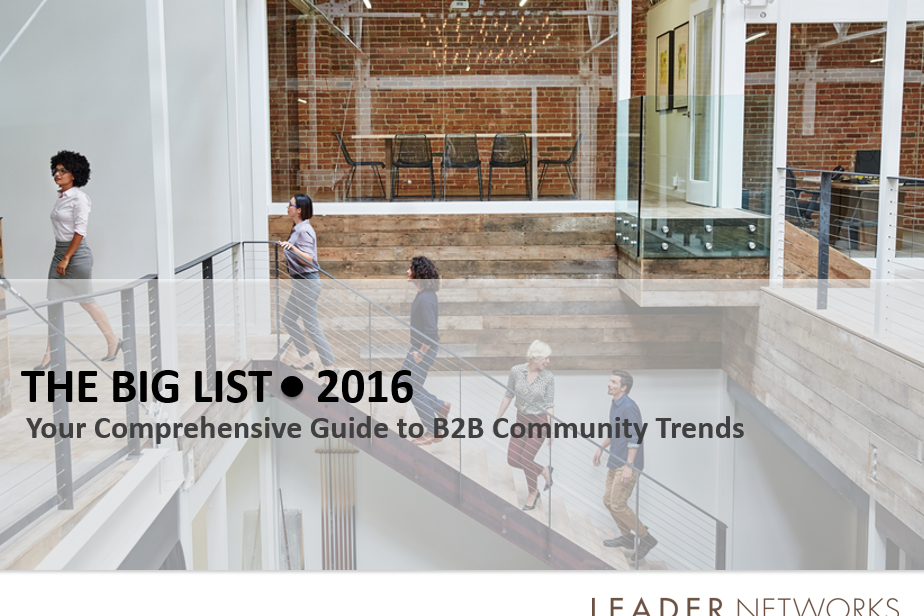Well, perhaps not every B2B online community secrets is revealed – as we have to reserve some future blog fodder- but hopefully we share a few key nuggets! This blog post occurred originally on B2B Marketing Portal which is run by my colleague Jeff Simmons. Jeff is a thought leader on social selling, and runs a suite of public and subscription-based “Mastermind” groups on LinkedIn. We have a lovely conversation as follows ….
If you’re thinking about building an online community for your customers or partners, check out this enlightening interview with Vanessa DiMauro. Vanessa is a leading authority on B2B communities and founder and CEO of Leader Networks, LLC. Her work has been covered by leading publications such as the New York Times, the Wall Street Journal and CIO magazine. In part one of this interview, Vanessa reveals:
- The no. 1 reason why people participate in communities
- Why most communities fail
- A litmus test for forming online communities
- Keys to success every community manager should know
[Jeff] Why do B2B professionals participate in communities?
[Vanessa] Good question. My research partners, Don Bulmer and Peter Auditore and I launched a study called The Social Mind in partnership with the Society for New Communications Research. We found three main reasons why people participate in online communities.
The number one reason is to help another person. We all have a natural inclination to help, so there are problem-solvers, people who are just naturally helpful. In fact, the study reported that over 80% of people participate in online communities for this reason.
Next, there are fame seekers – people who want to get the spotlight. They’re often consultants or up-and-comers in their profession.
The third type is people with a problem to solve. If they think participating in the community will help them gain access to information they can’t get elsewhere, they’ll do it.
(Editor’s note: You can read more about this study here.)
In the professional world, we all have an expertise in something, and due to online communities, it is easier to find micro-experts at times of need.
For example, if you are looking for someone who is the world expert in a specific technology or a certain aspect of training, or HR that professional is now so much more reachable due to the advent of social networks This is one of the main reasons why professional communities are an especially effective way to share expertise and connect with like-minded people.
What’s the purpose of a community?
A variety of different reasons, but the most resilient reason is to advance customer or partner intimacy.
The climate conditions in this “new new” business economy are forcing or inspiring organizations to get closer to their partners or their customers. There’s a growing need because the world is changing, and competition is really global now.
Organizations are no longer competing just on price; there are many reasons that go into the buying decision. Customer problems are a lot more complex. Customers and partners need more help to fulfill their business mandates, so they need to engage in thinking about problems or opportunities.
There are changing needs that must be addressed faster and better.
Who are communities usually formed around?
It’s most frequently the customers. That’s usually the lowest hanging fruit: 
Providing customer service, answering questions, identifying new features and needs from the audience and trends to inform the direction of the organization, and how it aligns with the strategic footprint of the company.
But we’re also seeing a quiet revolution of organizations creating supplier and partner networks. They don’t get nearly as much attention, but if suppliers or partners are important to the organizations lifeblood, then often times they can be well served in a private gated community.
You’ve said old-line traditional companies often see the greatest returns from online communities. Why is that?
Because they tend to have been around for long enough to have refined business processes, and they value them very deeply. So it’s more natural for them to see the value of deep process re-engineering, of sorts, to incorporate and impact the work they do using social data.
You’ve been involved with communities for over 20 years, since the early days of the internet . What’s changed over the years?
Not that much, in terms of best practices. At the end of the day, people are people. They transfer knowledge and share ideas in certain ways.
The biggest challenge I see now is that communities used to be considered a strategic initiative. And we’ve sort of fallen back into thinking of them as a marketing program. Many times, communities are being used to broadcast information, as a marketing tool or tactic, and not as an opportunity for relationship-building.
Part of it is the tools are much easier and cheaper to build. So organizations can stand one up from a tool basis quite cheaply, and not pay heed to some of the human relationships and processes that need to be in place to make them successful.
But due to the current failure rate and some of the challenges in the industry, we’re coming back to the future, as the saying goes. Organizations are now starting to say, “Hey, communities aren’t a tool. They’re part of our strategic footprint, part of our customer and partner relations” and are giving them the strategic and operational attention they require to succeed.
What’s the success rate of online communities?
About 70% of online communities fail, according to Gartner, and word on the street is that it might even be a little higher.
Why is the failure rate so high?
A variety of reasons.
The main reason is because organizations often think of community as a software launch and not a line of business or an extension of their customer care and R&D offerings. So they choose a tool without paying heed to the strategy, business requirements or operational impact the community could and should have on the organization.
Lack of planning often leads to failure, and failure takes place when the community fails to thrive, or doesn’t hit the mission and vision of the community members it’s endeavoring to serve.
But the community can also remain an undervalued asset even when the community is thriving, if the information and insights gathered through the social channel aren’t used to impact core operations.
Why is there a disconnect between communities and a company’s core operations?
Because often times the processes don’t exist. Communities are frequently thought of as a marketing stand-alone, not part of the social selling, not part of the product R&D, not part of the innovation teams within the organization.
Members the time and effort into the dialogue, but the information doesn’t get leveraged. The core processes, the human processes, aren’t in place to mine those data and use them strategically to feed into the sales process or the product development process.
So there’s a disconnect – or disjointedness – between the community insights and the core processes.
That takes a lot of identification of the offline behaviors of the organization. How do they normally, for example, mine customer insights in order to accelerate a new product or an innovation?
That requires looking at how you normally do things, and then putting in place a process so that information is codified and presented in a way that is actionable and meets the needs of the line-of-business executive or owner.
What are some of the key success factors?
One of the litmus tests around successful B2B online communities is:
Does the organization have the power to convene their audience offline?
That’s often a bellwether for success in an online community is the power to convene offline. Can they get their core customers or partners or suppliers to come to an event in the real world? Are they willing to participate in user groups or in-person summits?
You have to have the power to convene.
Some other characteristics are that the customers or partners gain major value by learning from the experiences of others, and there’s an urgency to share these experiences.
So if you take a technology company or a pharmaceutical company, there’s a timeliness to information-sharing, and the customers or the partners gain value from those experiences in order to progress their specific healthcare trial or drug implementation for example.
What types of companies that should not consider building a community?
If the company’s offering doesn’t solve an important problem for the customers — if it’s a transaction of sorts where there’s not a complex situation to discuss — that tends to be better situated for social media sharing but not so much for online community.
If the complexity is not there, there’s not a lot for the participants to discuss.
So the problems need to be complex and the customers or partners must be willing to share information.
Another one is that the organization really has to supply continual product or service enhancements. If it’s a one-and-done, and the product or service hasn’t changed in 20 years, there’s not that much to talk about. There needs to be an evolution, new releases, new offerings that reintroduce the complexity of the needs.
Another one I would add as a conditional is organizational revenues have to depend on the product or service upgrade decisions. That’s not a mandate, but it’s helpful for larger organizations that have upgrades which creates an evergreen conversation.
Can you give us some examples of success?
They range in all different industries. One good example is LexisNexis Investigators Network. Last year they won the Forrester Groundswell Award. The purpose and mission of the community is to bring federal, state and local law enforcements together to share best practices around fighting crime.
You can’t do better than using community to make the world a safer place. There’s vibrancy and great benefits of that community to its members.
Another great example is Shell’s Future of Energy LinkedIn group. This group is a public forum where the LinkedIn community can participate in open conversation about key energy topics. The conversation is happening out in the open with Shell and it’s fantastic.
Hitachi is doing amazing things with their online community. They just launched their community this year, but they took an innovative approach to it. They’ve created four different communities under one umbrella.
They’ve got a customer community that’s dedicated to solving customer problems and surfacing up new product ideas. They have a community for the developers that work on their platform, because they are going to have a different kind of conversation.
They also have a partner network to help support their partners’ integration of the data storage solutions. And then they have a community for innovation-only, what the future of storage looks like.
(Editors Note: Read more about Hitachi’s community here.)
It all comes down to gives and gets. The community must give something to the members who participate, and the company must receive some value from the initiative, because it’s not a light footprint on the organization. So there must be balance for the customers or partners who are receiving the community and value for the organization sponsoring it.
What that happens, everyone wins.
___________________________________________________________
 Jeff Simmons interviews thought leaders and influencers at the forefront of B2B social media. To get updates when new interviews are posted on his blog, subscribe by email or follow on Twitter.
Jeff Simmons interviews thought leaders and influencers at the forefront of B2B social media. To get updates when new interviews are posted on his blog, subscribe by email or follow on Twitter.
Warning: Attempt to read property "base" on array in /home3/trusten9/public_html/leadernetworks/wp-content/plugins/wp-user-profile-avatar/shortcodes/wp-user-profile-avatar-shortcodes.php on line 665
Warning: Attempt to read property "base" on array in /home3/trusten9/public_html/leadernetworks/wp-content/plugins/wp-user-profile-avatar/shortcodes/wp-user-profile-avatar-shortcodes.php on line 665
Warning: Attempt to read property "base" on array in /home3/trusten9/public_html/leadernetworks/wp-content/plugins/wp-user-profile-avatar/shortcodes/wp-user-profile-avatar-shortcodes.php on line 665
Warning: Attempt to read property "base" on array in /home3/trusten9/public_html/leadernetworks/wp-content/plugins/wp-user-profile-avatar/shortcodes/wp-user-profile-avatar-shortcodes.php on line 665
Vanessa DiMauro
Internationally recognized independent thought leader on social business strategy and operations with a specialty in online community. I help organizations drive top line growth through innovative digital strategy design and thoughtful execution. I have successfully led 60+ strategic social business initiatives for the world's most influential organizations over my 20 years as a social business executive and serve on a number of boards. My award-winning track-record is fueled by passion, experience and research.
My work has been covered by leading publications such as the New York Times, the Wall Street Journal and CIO Magazine and was recently named a Social Marketing Master by Forbes. As a former Executive in Residence at Babson College, Olin School of Management, I am an engaging and informational educator and keynote speaker.
Related Posts
November 7, 2016
Survey: Can you show the business impact of your online community?
“The Business Impact of Online Communities” study
October 11, 2016
7 Key Trends in Online B2B Customer Communities
The Big List of B2B Online Customer Communities is the most comprehensive list…
September 8, 2014
Big List 2.0: The Top B2B Online Customer Communities 2014
I am thrilled to share the most comprehensive directory of B2B online customer…


